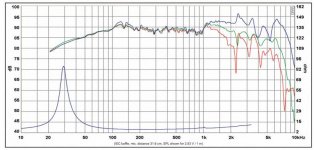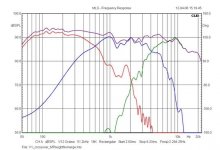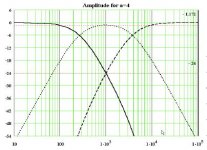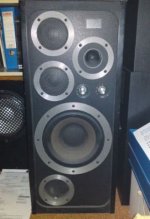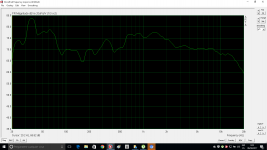What's the matter with you two? You have turned a 3 hour job into a loudspeaker nightmare project.
You are welcome Lojzek.
I'd strain myself less if the speakers were sent to me to build the whole filter from the scratch than trying to communicate the solution online. 

Thanks for your offer but unfortunately Croatia is very far from Catalonia, you need the drivers but also the big and loud cabinets.
I'd strain myself less if the speakers were sent to me to build the whole filter from the scratch than trying to communicate the solution online.
You dont comunicate on line nor anywhere anytime any way...😀
Thanks for your offer but unfortunately Croatia is very far from Catalonia, you need the drivers but also the big and loud cabinets.
So you think that was an offer. Hmm, I'll have to work on my conversation skills more seriously.
So you think that was an offer. Hmm, I'll have to work on my conversation skills more seriously.
Skiiillls? Conver whaaat?😀
I agree with Lojzek, this topic has developed into a farce. Endless postings of minor changes to a homebrew lash-up ( certainly not by a speaker designer with ability) and asides from ,perhaps a well wishing individual whose only material is from other sources and a simulator. Moderators where are you ?
I agree with Lojzek, this topic has developed into a farce. Endless postings of minor changes to a homebrew lash-up ( certainly not by a speaker designer with ability) and asides from ,perhaps a well wishing individual whose only material is from other sources and a simulator. Moderators where are you ?
Please keep clean that big nasty mouth with bleach before speaking and please remember that you haven't brought anything useful to Merlin's purpose from the beginning of the whole story...

Last edited:
I sort of agree we are losing our way here. Where are we going with this?
8'' SB23NRXS45-8 :: SB Acoustics

All looks quite promising to me. A 10" woofer that will work well enough below 500Hz. Troels Gravesen likes this sort of thing, and so do I:
You don't have to understand function of a complex variable to know that a 10" bass in 50 litres is about right. Reflex or closed box depending on the magnet size. And a three way is all about the midrange, relieved of bass and top end duties to play to its strengths.
My own view is that you can get things extremely right with a flat impedance and even doubling up the midrange units for low distortion. But, really a three way works very well. Thanks to Steen Duelund for the correct theory.
8'' SB23NRXS45-8 :: SB Acoustics
All looks quite promising to me. A 10" woofer that will work well enough below 500Hz. Troels Gravesen likes this sort of thing, and so do I:
SEAS Kit 503It's not often you sit in front of a pair of speakers and have this spine chilling feeling when the music starts. Play track 5 from Nils Lofgren, play it loud - real loud - and it's like sitting front row, looking up on the guitar. It's all there.
Forget about silver cables, golden binding posts, Mundorf Supreme and all that crap! Get an old 12-13" (good) paper cone and let it run up to 5-600 Hz. Give it 50-100 litres of volume or as much as your wife allows. Get a decent 5" paper mid and don't pay more than 50 $ for the tweeter! Get some electrolytic caps and - most importantly - make a good crossover and you're there.
You don't have to understand function of a complex variable to know that a 10" bass in 50 litres is about right. Reflex or closed box depending on the magnet size. And a three way is all about the midrange, relieved of bass and top end duties to play to its strengths.
My own view is that you can get things extremely right with a flat impedance and even doubling up the midrange units for low distortion. But, really a three way works very well. Thanks to Steen Duelund for the correct theory.
Attachments
I sort of agree we are losing our way here. Where are we going with this?
8'' SB23NRXS45-8 :: SB Acoustics

All looks quite promising to me. A 10" woofer that will work well enough below 500Hz. Troels Gravesen likes this sort of thing, and so do I:
SEAS Kit 503
You don't have to understand function of a complex variable to know that a 10" bass in 50 litres is about right. Reflex or closed box depending on the magnet size. And a three way is all about the midrange, relieved of bass and top end duties to play to its strengths.
My own view is that you can get things extremely right with a flat impedance and even doubling up the midrange units for low distortion. But, really a three way works very well. Thanks to Steen Duelund for the correct theory.
With all my respect I don't understand your post.
...and please remember that you haven't brought anything useful to Merlin's purpose from the beginning of the whole story...
Firstly, this isn't true at all and secondly, I am embarrased to read things like that even though it wasn't directed at myself. Sapienti sat!
For me the last curve obviously looks better, the 10uF no BR stuff, but...
We have changed many things lately... Sound wise what's your feeling? For better or worse?🙄
Me deaf...😀
For better: big difference bass , I added 1R to attenuate the tweeter and sounds better.
Attachments
Last edited:
Hi Merlin, nice thing you have going on here.
Great choice of drivers. It would be great if you could measure distortion. It would be interesting to see the distortion relations between drivers.
Great choice of drivers. It would be great if you could measure distortion. It would be interesting to see the distortion relations between drivers.
Lojzek that's the FR of your filter without your tweeter xover (using the the 2nds order LR12 original) and without the first resistor to attenuate the SS.
Attachments
Last edited:
Back again to 20uF on the SS?🙄
Marchando una de gambas!!!!
Hi Merlin, nice thing you have going on here.
Great choice of drivers. It would be great if you could measure distortion. It would be interesting to see the distortion relations between drivers.
If you tell me how to do it?
Marchando una de gambas!!!!
Cachondo... Seriously I am curious to know the value you are using 15,10,20uF?
If you tell me how to do it?
From arta manual:
http://www.artalabs.hr/download/ARTA-user-manual.pdf
By using the Farina method [7], ARTA can simultaneously estimate the frequency response and levels
of harmonic distortions from the measured PIR. To apply this method, following measurement
conditions have to be fulfilled:
1) The impulse response must be measured with a logarithmic swept-sine excitation (defined in
Section 5.2).
2) The length of the excitation sequence should be 64k or larger.
3) Measurements have to be done in a ‘Single channel mode’, with the check box ‘Center
peak of impulse response’ selected (see Fig. 5.3).
After obtaining impulse response in the PIR window the user has to:
1) put the cursor few samples in front of the peak of the impulse response (but less than 250
samples before the peak), and
2) press keys Shift+F12 or click menu command 'Analysis->Frequency response and
distortion'
ARTA automatically does all necessary calculations and shows results in the window ‘Frequency
Response and Distortions’, shown in Fig. 6.13 and 6.14. Depending of state of the push button
labeled ‘Dist(%)’ it shows level of harmonics (H2, H3, H4) in dB or percentage of distortion (D2, D3,
D4).
Last edited:
- Status
- Not open for further replies.
- Home
- Loudspeakers
- Multi-Way
- Xover to filter woofer SB 23NRSX45-8
